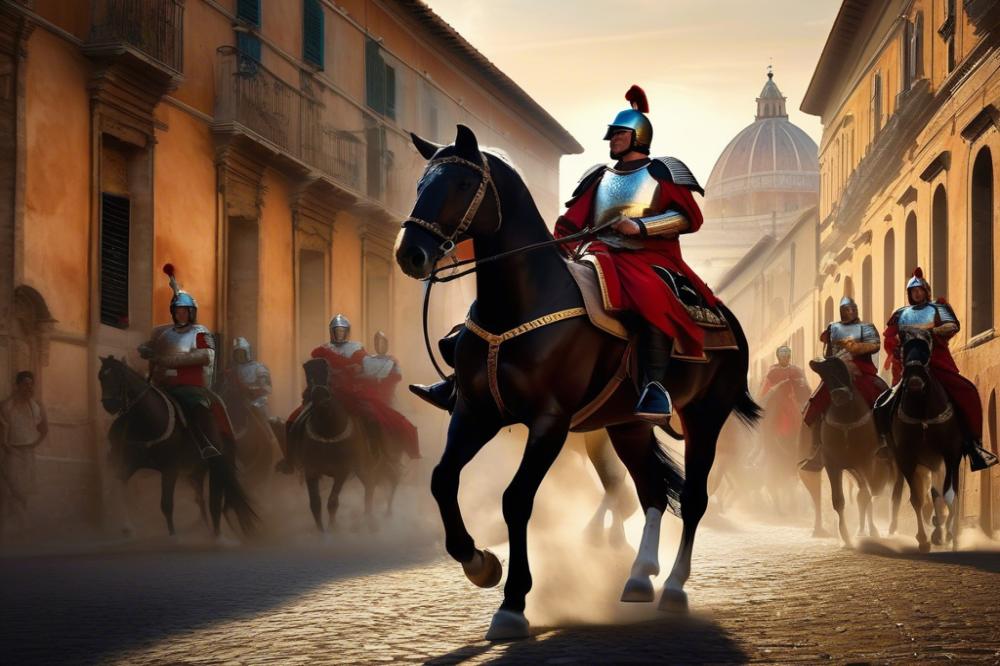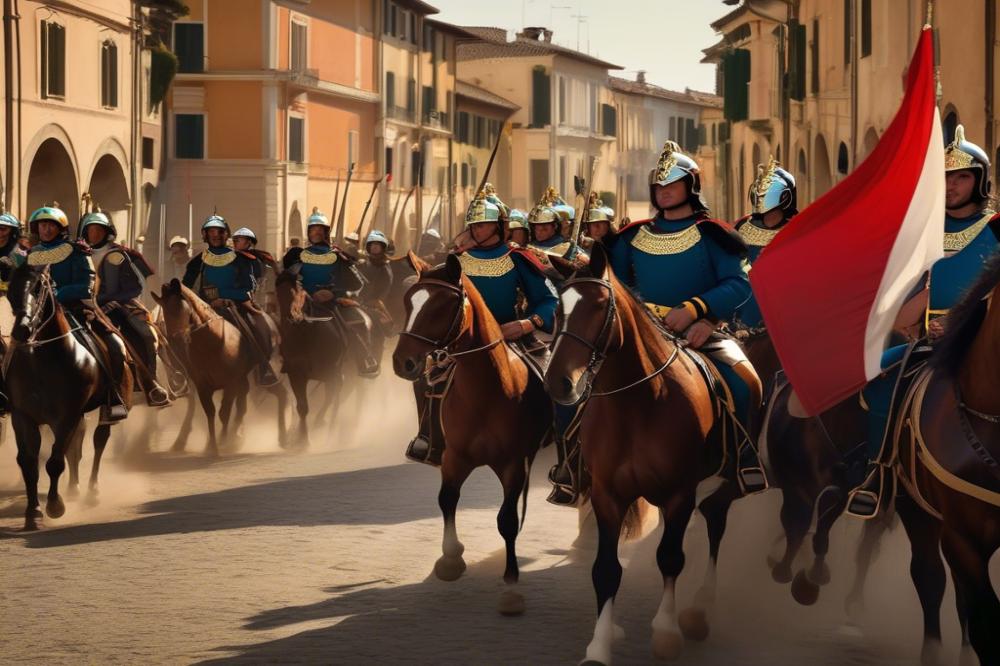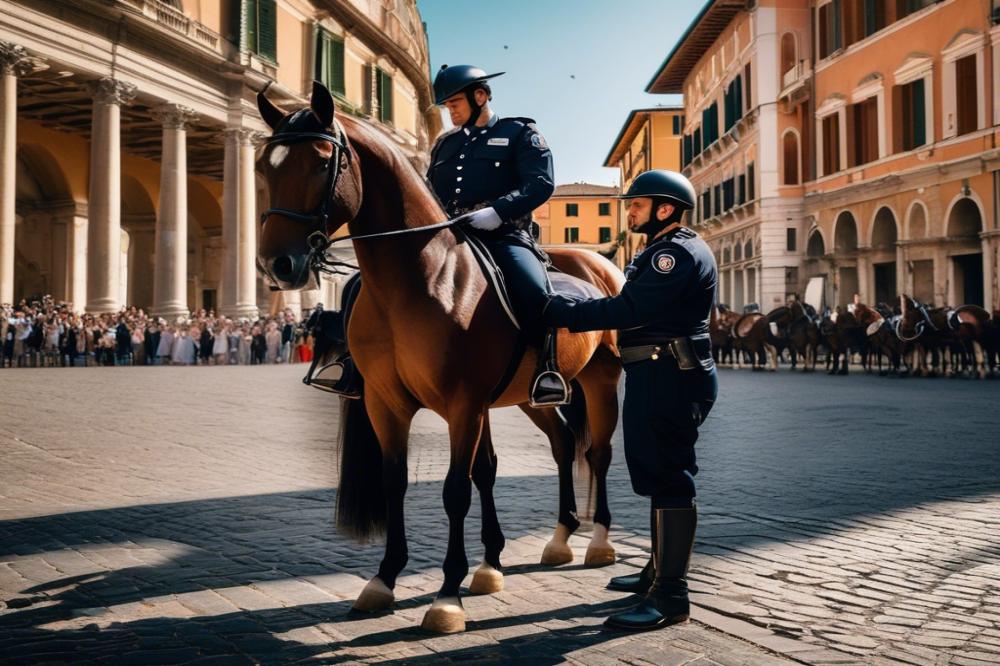Introduction
Horses have played a significant role throughout Italy’s rich history. From ancient times, they carried warriors into battle, helping shape the country’s military might. As empires rose and fell, horses remained central to transportation and communication. Their strength and loyalty made them essential companions to countless generations of Italians.
In modern times, that historical bond has evolved. The role of horses in law enforcement has become increasingly important. While technology and vehicles dominate contemporary policing, horses bring a sense of tradition, charm, and practicality. They can navigate crowded urban areas with ease, acting as both a tool for crowd control and a calming presence amid chaos.
The inclusion of productive police horses within Italian police units reflects a blend of past and present. These majestic animals serve not only to support officers in their duties but also to connect the community to its heritage. Cavalry History still resonates, influencing how people view law enforcement today. When officers ride horses, they evoke a feeling of approachability and trust. This unique partnership continues to reinforce the cultural significance of horses in Italy, bridging history with modern policing efforts.
Historical Context of Horses in Italian Law Enforcement

Throughout history, Italy has seen the significant role of horses in various aspects of life. Ancient cavalry units thrived during the times of the Roman Empire. These horse-mounted soldiers were essential for both warfare and policing duties. Their speed and agility allowed them to cover large areas quickly. This made them ideal for maintaining order in provinces and protecting trade routes.
Horses were not just tools of war; they also served in traditional military functions, which often blurred the lines between policing and battlefield roles. Mounted troops were responsible for patrolling, chasing down criminals, and ensuring safety in the streets. Cavalry units offered a visible police presence that was often respected—and feared—by locals.
As society evolved, so did the need for horses in law enforcement. The transition from cavalry to modern mounted police units occurred gradually. The invention of advanced transportation methods changed how police operated. Yet, horses continued to hold a place within certain units because they serve specific purposes. They allow officers to navigate crowded events more effectively. Public gatherings benefit from the visibility and approachability of these officers on horseback.
Today, mounted units utilize horses not only for their practical advantages but also for their symbolic significance. Communities often view horses as a bridge between the police and the public. This legacy stretches back to ancient times, and it remains a crucial part of Italy’s law enforcement history. The blend of ancient traditions with modern practices highlights the enduring relationship between horses and police duties.
The Structure and Function of Italian police units

In Italy, various police units actively incorporate horses into their operations. These units range from the Carabinieri to municipal police forces. Each unit has specific roles where equestrian skills come into play. Undercover work, public events, and crowd control are some of the contexts where mounted officers are essential. The presence of officers on horseback often signals authority and respect.
Overview of the Different Police Units Utilizing Horses
The Carabinieri, a branch of Italy’s armed forces, employs horses for patrols in cities and rural areas alike. Urban areas benefit significantly from the visibility provided by these units. Additionally, local police divisions often use mounted units during festivals and large gatherings. Each agency recognizes the horse as a tool in maintaining public relations. It also serves as a bridge between law enforcement and the communities they protect.
Details on Equestrian Patrol Practices in Urban Settings
Patrolling on horseback allows officers to cover more ground than foot patrols. Officers can also see over crowds, which gives them a strategic advantage. Communication with the public is easier when one is on a horse. Engaging with citizens fosters trust and approachability. Safety during this type of patrol is a priority, both for the horse and the officer. When navigating busy streets, training is vital to ensure smooth operation.
Importance of Police Horses in Maintaining Public Safety and Order
The role of police horses extends beyond mere visibility. They act as a calming presence in potentially volatile situations. Crowded events, such as parades or sports matches, often require careful management. Officers mounted on horses can effectively direct crowds and deter disorderly behavior. The sheer size of a horse can discourage aggressive actions from individuals in a crowd.
Public events see a unique benefit from the presence of horses. Bystanders are often drawn to mounted officers, creating an opportunity for dialogue. Such interactions enhance community relations and promote a positive image of law enforcement. All these factors contribute to a more harmonious environment, particularly in urban centers.
Training and Welfare of Police Horses
Training programs for police horses are extensive and rigorous. These animals need to be well-prepared for various situations they might face in the line of duty. Initially, basic obedience is the main focus. Officers teach horses to respond reliably to commands. As training progresses, horses are introduced to scenarios like crowds, loud noises, and other stressors. This exposure helps them remain calm during intense situations.
Alongside training, animal-assisted policing plays a significant role. Mounted officers build trust with their horses, fostering a strong bond between them. This relationship is essential. Communication becomes seamless as both horse and rider learn to understand each other. Equipped with this connection, officers can navigate their environments better, making police work more effective.
Welfare standards for these animals are crucial. Proper care includes nutrition, veterinary check-ups, and ample rest. Physical health directly affects performance in the field. Regular exercise is equally important, ensuring horses remain fit and agile. Mental well-being should not be overlooked either. Horses often receive downtime, allowing them to relax and recharge.
Challenges exist in managing equestrian teams. Incidents involving fear or stress can impact a horse’s behavior. Addressing within-training problems promptly is essential for success. Moreover, guidelines should be in place to maintain the welfare of both animals and their riders. Best practices involve ongoing education for officers about horse care. This knowledge leads to better management on the job.
Understanding each horse’s personality can also help in overcoming difficulties. Riders should know when their horses feel uneasy and respond accordingly. By adapting to each animal’s needs, officers can maximize the effectiveness of their teams. Fostering a supportive environment helps ensure that all individuals thrive, both equine and human alike. Maintaining a focus on both training and welfare is vital for successful law enforcement integration.
Cultural Significance of Mounted Police in Italy
Mounted police units represent an enduring connection to Italy’s heritage and tradition. Since ancient times, horses have played a crucial role in various aspects of Italian life, from agriculture to warfare. This historical significance transcends the years, establishing a unique link between the past and modern law enforcement.
Public perception of these units in urban areas often reflects a sense of nostalgia. Many citizens appreciate their presence as a reminder of Italy’s rich history. Children are particularly fascinated by the sight of officers on horseback. Horses bring a sense of majesty and authority that is different from standard patrol cars. Their visual appeal can make officers seem more approachable.
Community relations improve significantly with equestrian patrols. Officers on horseback can engage directly with the public in a way that is difficult for those in vehicles. This face-to-face interaction fosters trust and encourages positive dialogue. Many view mounted patrols as a bridge between law enforcement and local citizens, helping to reduce tension in crowded urban settings.
Furthermore, the presence of these units can enhance community events and festivals. People often feel safer when equestrian patrols are nearby. These patrols contribute to an atmosphere of openness. This is particularly important during gatherings, where large crowds can pose challenges for law enforcement. The calming presence of a horse can ease anxiety among the public.
Overall, mounted units play a pivotal role in shaping how the community interacts with law enforcement. They symbolize a time-honored tradition while fulfilling modern responsibilities. As society continues to evolve, these units maintain their relevance by engaging citizens in meaningful ways.
International Comparisons of Police Horses
Overview of police horse units in other countries
Mounted police units exist worldwide. In places like the United States and the United Kingdom, horses play a significant role. Officers on horseback patrol crowds during events. This approach provides high visibility. In Brazil, horses are utilized in urban areas. Officers on horseback can navigate through congested streets more easily than patrol cars. Other regions, such as Canada, also deploy mounted units for similar reasons. Many countries recognize the historical importance of these majestic animals. Their presence often brings a sense of safety and calm.
Comparative analysis of the effectiveness of mounted police globally
Effectiveness varies from one country to the next. Some studies suggest mounted units help reduce crime rates during public events. Greater visibility can deter potential troublemakers. Patrols on horseback allow officers to engage with the community. This builds trust and fosters a sense of belonging. In cities known for high tourist traffic, mounted police can interact positively with visitors. However, challenges exist. In densely populated areas, horses may experience stress. More noise and crowds can affect their ability to function well.
Lessons learned from international practices in Italian police units
Gaining insights from other nations can improve local practices. For instance, adopting community engagement techniques seen in the UK might be useful. Encouraging officers to cultivate relationships can strengthen community ties. Training methods adopted from countries known for successful mounted units can enhance skills. Techniques that prioritize animal welfare support healthier and happier horses. Various countries demonstrate that collaboration among mounted units leads to success. Learning from international experiences can bolster effectiveness and reliability in Italian policing.
Final Thoughts on the Role of Horses in Italian Law Enforcement
Throughout history, horses have played vital roles in various aspects of life, including law enforcement. From their origins in ancient cavalry to their modern-day presence in Italian police units, these animals have adapted to the changing needs of policing. The evolution has been remarkable, transitioning from a primary method of transportation to becoming symbols of authority and community connection.
Police horses enhance public safety in multiple ways. Their physical presence can deter crime and provide a sense of security during large events. Additionally, officers on horseback often find it easier to engage with the community. This connection fosters trust, making citizens feel more comfortable approaching law enforcement with their concerns. Overall, these animals are more than just tools; they serve as ambassadors for police departments everywhere.
Looking ahead, integrating horses into Italian police units requires thoughtful consideration. As urban areas grow, adapting their role to fit modern environments is crucial. Technology may offer alternatives, yet the bond between horses and officers remains irreplaceable. Future considerations should explore sustainable practices for caring for these steeds. Training methods must evolve to maintain effectiveness in diverse settings. The relationship between society and these noble animals will continue to shape public safety as we move into the future.



